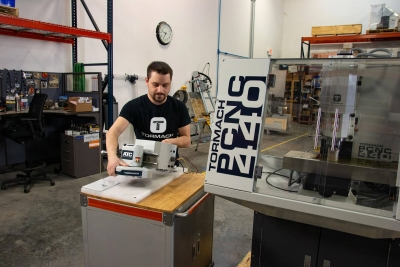
Tormach Inc., the industry’s leading supplier of affordable and compact CNC machines, has announced it is now offering assembly services for its line of machines, including the 1100M/MX & 770M/MX CNC Mills, the PCNC 440 Mill, and the Slant-PRO 15L.
By default, Tormach ships its machines unassembled to its customers as a way to keep costs down. Now, for a reasonable fee, customers now have options. Assembly services are performed at Tormach’s facility and offered in a tiered system. Customers can choose the specific accessory or upgrades they would like to have pre-installed before the machine ships, such as an Automatic Tool Changer or Power Draw Bar, or they can opt for full machines assembly.
An in-house Tormach professional will install, align, and test all pre-installed components (if partial assembly is chosen) and major systems to the machines for full assembly. This allows customers to speed up the time to commission their new machines quickly at their shop once they arrive.
“We heard from many customers that they would prefer it if we would provide our machines fully assembled or assist in installing major accessories, and the additional cost was well worth it to them,” said Lori Morrison Bufalo, Tormach’s Marketing Director. “We have decided to add this service as a way to make life easier for our customers and much like our philosophy with machine design, every customer has different needs, so you have the ability to pick and choose what you’d like installed by our technicians.”
Examples of some of the items Tormach can assemble on its machines include:
- Automatic Tool Changers (ATC)
- High Performance Servo Motors
- Motorized 4th Axis Rotary Tables and Fixed Vises
- High-Performance Spindles
- Coolant Systems
- Enclosures (Dependent Upon Shop Door Dimensions)
- PathPilot Operator Consoles
- Machine Stands
Tormach also is offering on-site installation services at customer locations. “A Tormach technician will schedule time at a customer’s facility once the machine arrives, and they will get it up and running,” said Bufalo. “Every step, from stand and enclosure assembly to accessory install and dialing everything in, this is a premium service that gets you making chips really fast.”
Contact Details
Related Glossary Terms
- computer numerical control ( CNC)
computer numerical control ( CNC)
Microprocessor-based controller dedicated to a machine tool that permits the creation or modification of parts. Programmed numerical control activates the machine’s servos and spindle drives and controls the various machining operations. See DNC, direct numerical control; NC, numerical control.
- coolant
coolant
Fluid that reduces temperature buildup at the tool/workpiece interface during machining. Normally takes the form of a liquid such as soluble or chemical mixtures (semisynthetic, synthetic) but can be pressurized air or other gas. Because of water’s ability to absorb great quantities of heat, it is widely used as a coolant and vehicle for various cutting compounds, with the water-to-compound ratio varying with the machining task. See cutting fluid; semisynthetic cutting fluid; soluble-oil cutting fluid; synthetic cutting fluid.
- milling machine ( mill)
milling machine ( mill)
Runs endmills and arbor-mounted milling cutters. Features include a head with a spindle that drives the cutters; a column, knee and table that provide motion in the three Cartesian axes; and a base that supports the components and houses the cutting-fluid pump and reservoir. The work is mounted on the table and fed into the rotating cutter or endmill to accomplish the milling steps; vertical milling machines also feed endmills into the work by means of a spindle-mounted quill. Models range from small manual machines to big bed-type and duplex mills. All take one of three basic forms: vertical, horizontal or convertible horizontal/vertical. Vertical machines may be knee-type (the table is mounted on a knee that can be elevated) or bed-type (the table is securely supported and only moves horizontally). In general, horizontal machines are bigger and more powerful, while vertical machines are lighter but more versatile and easier to set up and operate.








